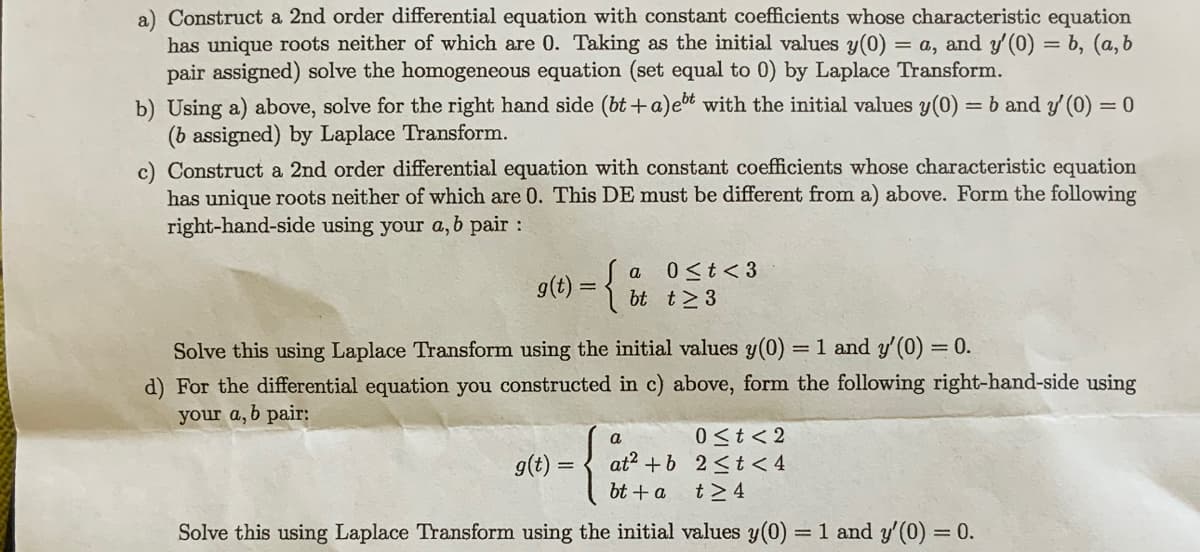a) Construct a 2nd order differential equation with constant coefficients whose characteristic equation has unique roots neither of which are 0. Taking as the initial values y(0) = a, and y'(0) = b, (a,b pair assigned) solve the homogeneous equation (set equal to 0) by Laplace Transform.
a) Construct a 2nd order differential equation with constant coefficients whose characteristic equation has unique roots neither of which are 0. Taking as the initial values y(0) = a, and y'(0) = b, (a,b pair assigned) solve the homogeneous equation (set equal to 0) by Laplace Transform.
Advanced Engineering Mathematics
10th Edition
ISBN:9780470458365
Author:Erwin Kreyszig
Publisher:Erwin Kreyszig
Chapter2: Second-order Linear Odes
Section: Chapter Questions
Problem 1RQ
Related questions
Question
a=-2 and b=1

Transcribed Image Text:a) Construct a 2nd order differential equation with constant coefficients whose characteristic equation
has unique roots neither of which are 0. Taking as the initial values y(0) = a, and y'(0) = b, (a, b
pair assigned) solve the homogeneous equation (set equal to 0) by Laplace Transform.
b) Using a) above, solve for the right hand side (bt+a)et with the initial values y(0) = b and y'(0) = 0
(b assigned) by Laplace Transform.
c) Construct a 2nd order differential equation with constant coefficients whose characteristic equation
has unique roots neither of which are 0. This DE must be different from a) above. Form the following
right-hand-side using your a, b pair :
g(t) = {
a
bt
g(t) =
0 ≤ t <3
t≥ 3
Solve this using Laplace Transform using the initial values y(0) = 1 and y'(0) = 0.
d) For the differential equation you constructed in c) above, form the following right-hand-side using
your a, b pair:
a
at² + b
bt + a
0 ≤t <2
2 <t
t> 4
Solve this using Laplace Transform using the initial values y(0)
= 1 and y'(0) =
= 0.
Expert Solution
This question has been solved!
Explore an expertly crafted, step-by-step solution for a thorough understanding of key concepts.
Step by step
Solved in 3 steps

Recommended textbooks for you

Advanced Engineering Mathematics
Advanced Math
ISBN:
9780470458365
Author:
Erwin Kreyszig
Publisher:
Wiley, John & Sons, Incorporated

Numerical Methods for Engineers
Advanced Math
ISBN:
9780073397924
Author:
Steven C. Chapra Dr., Raymond P. Canale
Publisher:
McGraw-Hill Education

Introductory Mathematics for Engineering Applicat…
Advanced Math
ISBN:
9781118141809
Author:
Nathan Klingbeil
Publisher:
WILEY

Advanced Engineering Mathematics
Advanced Math
ISBN:
9780470458365
Author:
Erwin Kreyszig
Publisher:
Wiley, John & Sons, Incorporated

Numerical Methods for Engineers
Advanced Math
ISBN:
9780073397924
Author:
Steven C. Chapra Dr., Raymond P. Canale
Publisher:
McGraw-Hill Education

Introductory Mathematics for Engineering Applicat…
Advanced Math
ISBN:
9781118141809
Author:
Nathan Klingbeil
Publisher:
WILEY

Mathematics For Machine Technology
Advanced Math
ISBN:
9781337798310
Author:
Peterson, John.
Publisher:
Cengage Learning,

